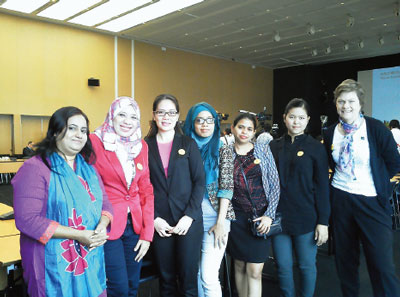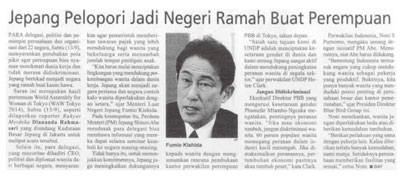Diplomatic Bluebook 2015
Chapter 3
Japan’s Foreign Policy to Promote National and Worldwide Interests
1.Strategic Communications with Other Countries
(1) Overview
Japan has long taken an active stance in explaining its diplomatic policy on the occasions of daily press conferences, official visits to foreign countries and speeches at international conferences by the Prime Minister, the Foreign Minister, other Ministers, and government officials. When media report on Japan’s basic stance or views on the recognition of history, maintenance of territorial integrity, and a wide range of other issues is released based on factual errors, an ambassador or consul-general will lead the efforts by Japan’s diplomatic establishments overseas to release a rebuttal based on objective facts. Japan also engages in regular and active communications with public via social media and websites.
In order to make Japan’s stance and views understood, it is also important to exchange views with experts and think tanks. An effective way is to invite experts and news/media personnel from around the world. To this effect, the Ministry of Foreign Affairs (MOFA) has been since 2011, inviting top influencers in social media outreach, in addition to conventional invitations of opinion leaders and news/media personnel. Japan also intends to support seminars on Japan by sending more Japanese experts abroad.
In order to attract the broadest possible public to Japan including people who may or may not be interested in Japan alike, the following actions are important: (1) offering information on the diverse attractiveness of Japan through all-Japan efforts of the government, private companies and local governments; (2) promoting outreach that reflects needs of the local community with participation of experts from both inside and outside of Japan; and (3) providing “one-stop-service” where all information related to Japan can be obtained. With this in mind, communication hubs are to be established in London, Sao Paulo and Los Angeles to implement aforementioned actions.
(2) Foreign Media’s Views on Japan and Communications through Foreign Media
In 2014, the policies of the Abe administration such as progress in Abenomics and “Proactive Contributions to Peace” based on the principle of international cooperation, attracted much attention from the foreign media. Also, active visits to foreign countries by Prime Minister Shinzo Abe and Foreign Minister Fumio Kishida in line with Japan’s “diplomacy that takes a panoramic perspective of the world map” captured further media attention.
Amidst increasing interest in Japan by foreign media, MOFA promptly and actively provides information and offers cooperation for press coverage to foreign media in order to gain understanding and support from the international community about Japan’s stance and efforts. In doing so, MOFA delivers strategic and effective communications by providing information to media outlet at an appropriate time in accordance with theme and contents.
As for communications through foreign media, information is provided to correspondents residing in Tokyo at regular press conferences by Foreign Minister Kishida and via press release materials. On the occasions of Prime Minister Abe’s and Foreign Minister Kishida’s foreign visits abroad and participation in international conferences such as G7/G20 Summit meetings and the UN General Assembly, MOFA arranges interviews, contribution of articles and press conferences with the foreign media. In 2014, 25 interviews by the prime minister, 19 interviews by the foreign minister, and eight international press conferences by the prime minister were conducted.
In addition, MOFA invited 93 journalists from abroad including those media that have no correspondent in Japan, to provide media opportunities so that they could deepen understanding of Japan’s priority policies and stance. It also contributes to communicating to the world the attractiveness of Japan, including that of local regions.
For instance, Foreign Minister Kishida contributed an article to The Wall Street Journal, a world-renowned newspaper, on the occasion of the Ministerial Meeting of the Non-Proliferation and Disarmament Initiative (NPDI) in Hiroshima in April to introduce Japan’s engagement in achieving “a world without nuclear weapons.” Furthermore, a total of 10 journalists from each 10 NPDI participating country were invited, leading a wide press coverage of the realities of atomic bombings and Japan’s commitment to disarmament and nuclear non-proliferation. At the APEC Summit in Beijing in November, Prime Minister Abe held a widely-reported press conference and directly delivered to a large number of foreign media a statement about the discussions at the APEC and the Japan-China summit meeting. In some cases when articles by foreign media on Japan included factual errors, MOFA promptly provided comments and sent letters to the editor to help them produce articles based on accurate facts and understandings.
 Seiji Kihara, Parliamentary Vice-Minister for Foreign Affairs, attending the Brussels Forum (Brussels, March 22)
Seiji Kihara, Parliamentary Vice-Minister for Foreign Affairs, attending the Brussels Forum (Brussels, March 22)
ー Communicating Japan’s Attractiveness to the World through the Foreign Media ー
 Journalists invited to cover WAW!
Journalists invited to cover WAW!
The Ministry of Foreign Affairs (MOFA) proactively promotes public relations with the aims of fostering deeper understanding of Japan’s key policies and positions, and of communicating Japan’s attractiveness including its local regions. As part of these efforts, MOFA invites foreign journalists to Japan to provide opportunities for press coverage including interviews, briefings and on-site visits.
In 2014, the invited foreign media personnel covered themes such as Japan’s economy, foreign and security policies, infrastructure for export and culture including “Cool Japan.” The guest journalists, for instance, showed a keen interest in the transportation infrastructure and networks that we use every day, and were especially surprised at Japan’s bullet train for its technology, punctuality and high quality passenger services. Japan’s culture, including Japanese cuisine and pop culture, also attracts much interest in Europe, America, and Asia. Sometimes we are surprised by their fresh perspectives for the description of Japan. One example is unexpected high praise from South African News for the Japanese elementary school students undertaking rotationed duties for school lunch.
In September, coinciding with the World Assembly for Women in Tokyo (WAW!) symposium, female journalists from eight countries of Asia, the Middle East and other regions were invited to Japan. Following interviews with the WAW! participants and government officials, these journalists wrote a number of articles for publication in each country, through which the discussions of the symposium as well as the various attractiveness of Japan were communicated widely to the world. Furthermore, many of them eagerly gathered information of Japan’s environment and disaster prevention technologies, medical systems, and measures against aging society to help resolve similar issues that their home countries are also facing.
MOFA will continue to communicate Japan’s policies and attractions to people around the world through the foreign media.
Examples of articles covering WAW! are as follows;
 Rakyat Merdeka (Indonesia), September 16, 2014
Rakyat Merdeka (Indonesia), September 16, 2014
“Japan Will Become a Pioneer of Woman-Friendly Societies.” Rakyat Merdeka of Indonesia 16 September 2014. “Representatives, politicians, and leaders of corporations and organizations from 22 countries around the world spoke about the need for a change in mindsets to ensure that women are able to work comfortably and without discrimination. Japan aims to become a woman-friendly society.”
“Six Lessons that the People of Egypt Should Learn from the People of Japan.” Al-Youm Al-Sabea of Egypt 21 October 2014. “Japan is one of the safest countries in the world. Safety does not only mean a small number of thefts and burglaries, but also encompasses consideration for the rights of others at all times.”

